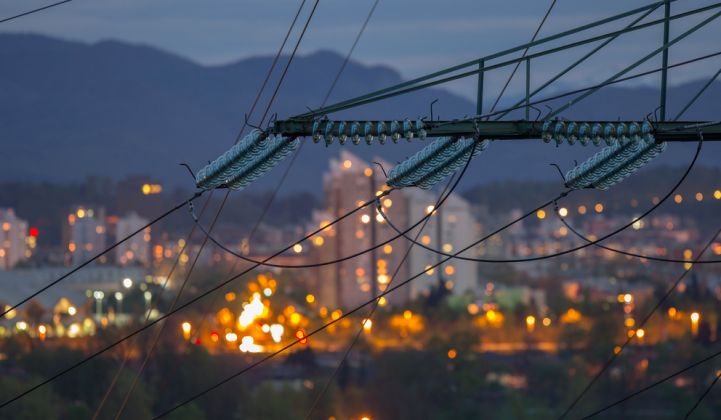Distributed energy and grid intelligence won’t be able to stop a hurricane or prevent hackers from trying to disrupt the grid. But they could play a role in keeping the grid running amidst storms or cyberattacks, or by helping it recover after an outage.
On Tuesday, the Department of Energy announced $50 million in funding for projects aimed at making that vision a reality -- though not specifically as part of recovery efforts from hurricanes Harvey and Irma.
At the center of the funding is $33 million for seven projects from the Grid Modernization Laboratory Consortium. The GMLC launched early last year with $220 million in funding for 88 projects around the country. The consortium was created as part of DOE’s grid modernization initiative to coordinate the work of its national laboratories with public and private-sector partners.
Last year’s Grid Modernization Initiative awards were largely “foundational” in nature, with lots of consortia of standards bodies taking about “grid modernization metrics” and “stakeholder-driven architecture.” But this week’s awards are far more specific -- and many are tied to ongoing efforts on the grid edge integration front.
One of the widest-ranging is a project entitled “Increasing Distribution Resiliency Using Flexible DER and Microgrid Assets Enabled by OpenFMB.” That last term stands for Open Field Message Bus, the standard-under-development for communications between devices like smart meters, grid sensors, smart inverters and other DERs.
Besides the three national labs involved -- Pacific Northwest, Oak Ridge and the National Renewable Energy Laboratory -- the biggest utility partner in the project is Duke Energy, the utility giant that’s been a big proponent of OpenFMB. Duke is joined in this project by Pacific Northwest utility Avista, as well as GE Grid Solutions (formerly Alstom), University of North Carolina-Charlotte, University of Tennessee and the Smart Electric Power Alliance.
The goal of this $6 million project is to see if OpenFMB-maintained networks of DERs and microgrids can be run securely and reliably enough to be used as “boundary conditions” (i.e., as part of the envelope of constantly updated data that tells utilities and grid operators what they can and can’t do). Duke has a microgrid or two up and running to test out these concepts.
Interested to learn more about how these projects fit into the bigger picture for the power sector? Join us at the U.S. Power and Renewables Conference in Austin, Texas.
Another project with a $6 million grant, and the goal of mitigating grid disruptions through DERs, is called Grid Resilience and Intelligence Platform. It’s a more software-focused project, as evidenced by the participation of the SLAC National Accelerator Laboratory and Lawrence Berkeley National Lab, and has set a goal to “anticipate, absorb and recover from grid events by demonstrating predictive analytics capabilities, combining state-of-the-art artificial intelligence and machine-learning techniques, and controlling DERs.”
The key industry partner on this project is Tesla, owner-operator of fleets of SolarCity rooftop PV systems and a small but growing number of behind-the-meter Powerwall batteries. Other partners include Southern California Edison, Packetized Energy, Vermont Electric Co-Op, University of California-Berkeley, Stanford University and the University of Vermont.
Home energy management systems are the focus of another $6 million project being run by Pacific Northwest National Laboratory and Oak Ridge, two labs with decades of experience in field-testing home-to-grid integration. Big utilities involved include Southern Company, Tennessee Valley Authority, Duke, Con Edison, Chattanooga, Tenn.’s Electric Power Board and Jackson EMC.
Two more projects are aimed more at the post-blackout phase of grid reliability. The first is a $6.2 million project dubbed Radiance, featuring grid giant Siemens and a host of university partners. The project is proposing to deploy “multiple networked microgrids, energy storage and early-stage grid technologies” with partners including Alaska’s Cordova Electric Cooperative, the Alaska Center for Energy and Power and Alaska Village Electric Cooperative.
The other, dubbed CleanStart-DERMS, is focused on a “DER-driven mitigation, black-start and restoration strategy for distribution feeders” (i.e., how distributed energy assets could help keep isolated feeders running in the moments after a blackout). This could be useful, but also dangerous if the utility isn’t kept informed about it, which means that it will have to include an “applied robust control, communications and analytics layer, and coordinated hierarchical solution."
The lead technology provider on this project is Smarter Grid Solutions, a Scottish startup with a distributed energy management platform operating across hundreds of megawatts of assets. Other private-sector partners include battery-maker-turned-developer EnSync, inverter vendor SolarEdge, and big-data software startup PingThings, as well as a host of Southern California utilities including Pacific Gas & Electric, Southern California Edison, the Southern California Public Power Authority and Riverside Utility.
None of these projects is expected to yield a commercially available product. But DOE noted that their results will provide key data on “technical and economic viability of integrated solutions” for the utilities, agencies and private-sector players working on these kinds of systems.
On the cybersecurity side of the coin, DOE announced more than $20 million in awards to 20 separate research projects aimed specifically at security-critical pieces of energy infrastructure. The projects come with such colorful acronyms as MEEDS (Mitigation of External-exposure of Energy Delivery System Equipment) and SASS-E (Safe & Secure Autonomous Scanning Solution for Energy Delivery Systems), and range from managing the cyberthreats inherent in the utility IT-OT connection, to managing security on a grid rich with DERs.
Join us for the U.S. Power & Renewables 2017 conference in Austin, Texas this November to meet with top regulators, utility executives and technology leaders dealing with the aftermath of Harvey, and applying its lessons to the nation as a whole. The two-day conference will include the solar expertise of GTM Research, the wind energy analysis of MAKE, and the broader energy and utilities expertise of Wood Mackenzie.



